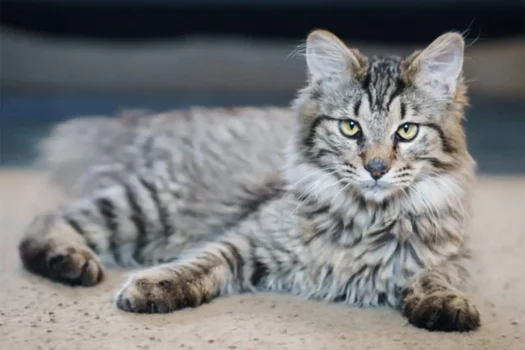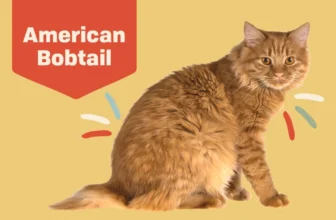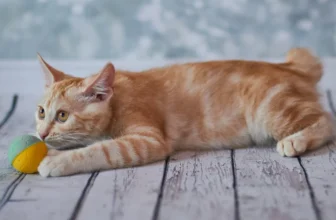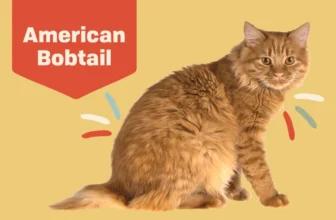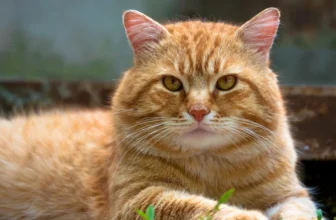As admirers of American Bobtails, we are constantly fascinated by their unique tails and their seemingly effortless balance and agility. However, have you ever wondered about the connection between their tail size and their incredible sense of balance? In this article, we will explore the intricate relationship between tail size and balance in American Bobtails. From the various genetic and environmental factors that affect tail size to the nutritional and grooming considerations that help maintain optimal tail health, we will delve into everything you need to know about this intriguing topic. So let’s dive right in and uncover the secrets of this fascinating feline trait!
The Importance of Balance for American Bobtails
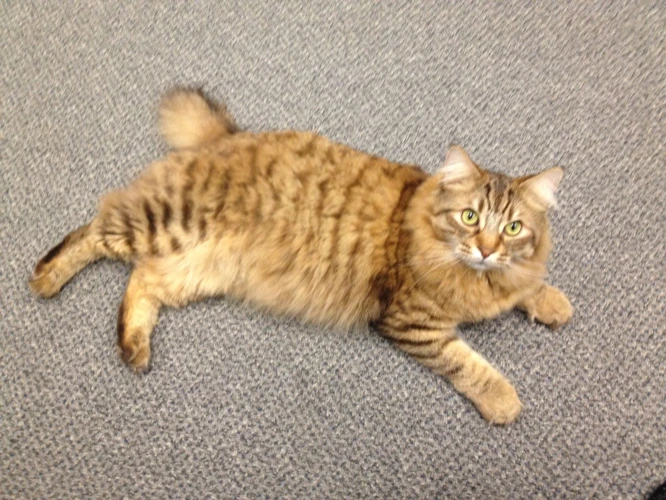
The American Bobtail cat is a unique breed that stands out for its distinct physical characteristics, including its shortened tail. Balance is crucial for all cats, but even more so for American Bobtails due to their bobbed tails. These felines rely heavily on their tails to maintain stability and navigate their environment. In this article segment, we’ll explore the importance of balance for American Bobtails and the role their tails play in it. We’ll also examine how different factors affect tail size and offer tips on how to maintain an optimal tail size for balance and agility. For more information on American Bobtail tails and their evolution, check out our article on American Bobtail tail evolution.
The Role of Tails in Balance
The tail plays a crucial role in maintaining balance for American Bobtails. A cat’s tail acts as a counterbalance, helping the body adjust to changes in direction and movement. It also plays a crucial role in communication with other cats and animals.
Without a tail, a cat would be less agile and less able to control its movements. In fact, the tail is so important that some breeds of cats have evolved unique tails to help them excel in specific environments. For example, the Manx cat has a very short or non-existent tail, which allows it to move swiftly and quietly through dense forests.
The American Bobtail, on the other hand, has a short tail with a unique shape that helps it balance and move quickly. The tail is slightly curved and has a flexible base, allowing it to move in almost any direction. It helps the American Bobtail make rapid turns, jump long distances, and land gracefully.
To understand the importance of the tail in balance, imagine a tightrope walker without a balancing pole. The tightrope walker would have to rely entirely on their leg muscles to maintain balance. Similarly, a cat without a tail would have a much harder time staying balanced while running, jumping, or climbing.
The tail is essential to a cat’s balance and agility. The American Bobtail, with its unique tail shape, is particularly adept at using its tail to control movement and maintain balance. If you want to learn more about the link between tail length and balance in American Bobtails, check out our article on tail length in American Bobtails.
The Unique Tail of American Bobtails
The unique tail of American Bobtails is one of the defining physical features of this breed of cats. Unlike most other cats, American Bobtails have short tails, which are highly expressive and loaded with muscles. Their tails are usually only a few inches long, and they are flexible and broad at the base.
Characteristics of American Bobtail tails:
- Short in length: American Bobtails’ tails are generally only a few inches long.
- Flexible: The tails of American Bobtails are highly flexible, enabling them to move their tails in many different directions.
- Broad base: The base of the tail is broad and muscular, which helps the American Bobtail maintain balance – especially when leaping or running.
American Bobtail cats’ tails are different from other short-tailed breeds like the Manx, which is usually tailless. While the Manx is born without a tail due to a genetic mutation, the American Bobtail has a naturally shorter tail that is the result of a natural mutation, as well as selective breeding.
The function of an American Bobtail’s tail is:
- Balance: The tail plays a critical role in maintaining balance, which is essential for a cat’s agility and coordination.
- Communication: An American Bobtail’s tail is highly expressive and can convey many different emotions, including happiness, anger, and fear.
- Protection: Because the tail is muscular and flexible, it can serve as a defensive weapon – helping the cat to ward off predators or attackers.
The unique tail of the American Bobtail is a testament to the breed’s agility, strength, and personality. To maintain proper balance and agility, it is essential to keep their tails in optimal health. Proper grooming and exercise can help to improve the overall health of their tails, which will contribute to their overall health and well-being. To learn more about how the tail shape and muscles of these cats affect their agility, read our article on Tail muscles and bobtail agility.
How Tail Size Affects Balance and Agility
The length and shape of a cat’s tail can have a significant impact on its balance and agility, and this holds true for American Bobtails as well. A longer and bigger tail can aid in providing better balance, especially when jumping or landing from heights. In contrast, a shorter tail may reduce the cat’s ability to stabilize itself, which will affect its balance and agility.
Additionally, the shape of the American Bobtail’s tail plays a unique role in its balance and agility capabilities. The tail is typically slightly curved or kinked, which helps with weight distribution and provides equilibrium for the cat while walking, running, or moving. The curve in the tail also makes it easier for American Bobtails to change direction quickly, which adds to their agility.
It’s important to note that while tail size and shape are essential for balance and agility, other factors such as genetics, diet, exercise, and environment also play a crucial role. As pet owners, it’s essential to pay attention to all these elements to ensure our cats maintain optimal health and fitness levels.
It’s fascinating to learn that different tail shapes and lengths hold different meanings in different cat breeds. To find out more about this topic, check out our article on different tail shapes and meanings in bobtails.
It’s also worth mentioning that the Bobtail gene is responsible for the unique tail of American Bobtails. If you want to know more about this fascinating breed, be sure to check out our article on the Bobtail gene in American Bobtails.
Maintaining an American Bobtail’s tail in optimal condition is vital for their health and wellbeing. If you want to know more about how to take care of their tail, then you might want to read our article on American Bobtail tail care.
Factors Affecting Tail Size in American Bobtails
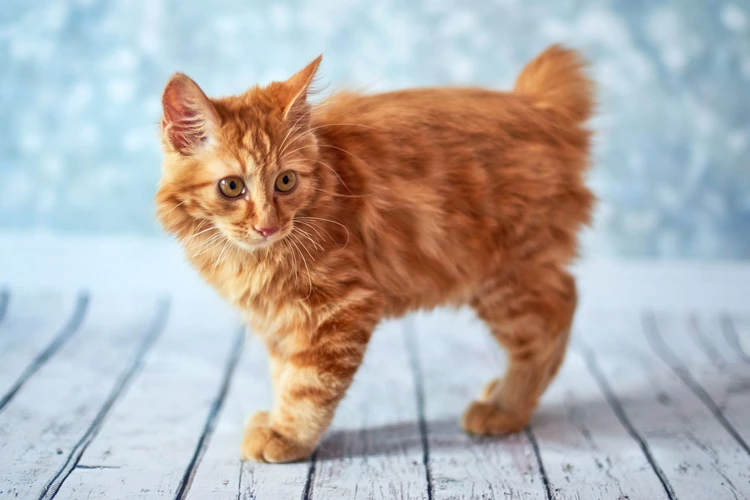
The tail of an American Bobtail is a defining characteristic of this unique breed. While the tail is typically short and has a distinctive “bobbed” appearance, the size of the tail can vary from one cat to another. There are several factors that can influence the size of an American Bobtail’s tail, including genetic factors, diet and nutrition, exercise and activity level, and environmental factors. Understanding these factors can help cat owners maintain the optimal tail size to promote balance and agility in their pets.
Genetic Factors
The genetic makeup of American Bobtails has a significant impact on their tail size, as well as other physical features. Strong genes can lead to larger tails, whereas weaker genes may result in shorter tails.
It’s important to note that tail size is not the only factor influenced by genetics. The genes also determine the cat’s overall body size, limb length, and musculature. Owners should closely examine the lineage of their American Bobtails to determine if size is a genetic factor in their breeding.
Certain genetic mutations can also affect tail size. The bobtail gene, for instance, is a dominant genetic mutation that is responsible for short tails in American Bobtails. This gene can be passed down from a cat’s parents and can lead to a wide range of tail lengths. However, having the bobtail gene alone does not necessarily cause balance or agility issues.
Owners looking to breed American Bobtails should carefully consider their cat’s genetics and choose breeding partners that complement their cat’s genetic makeup. Breeding for stronger genes can help improve overall physical health, including tail size and other important traits.
It’s worth noting that while genetics play a significant role in tail size, it’s not the only determining factor. Proper nutrition, exercise, and grooming can also help ensure the cat grows to its full potential. If unsure about how to approach breeding and genetic factors, consult with a veterinarian or a professional breeder.
Diet and Nutrition
American Bobtails, like any other breed of cats, require a balanced and nutritious diet to maintain their overall health and well-being. It is essential to feed them a high-quality diet, which should be rich in proteins, vitamins, and minerals to promote growth, support their immune system, and enhance their muscular strength. Feeding the right food in the right proportion can also contribute to maintaining the optimal size of their tail, which is crucial for their balance and agility.
Here are some essential dietary considerations for American Bobtails:
- Protein – Protein is an essential macronutrient for cats, and it should form a significant portion of their diet. Feeding protein-rich food helps to build lean muscle mass and improve the cat’s overall agility.
- Fats – Fats are a good source of energy for cats, and it should be included in their diet. The right amount of fat in their diet can help maintain a robust and healthy coat and skin. However, overfeeding fats can lead to obesity and other health issues.
- Carbohydrates – Carbohydrates are not essential for cats, but some cat foods contain them. If included in their diet, they should be in minimal amounts as cats are obligate carnivores, and their digestive system is not well equipped to digest carbohydrates.
- Vitamins and Minerals – Cats need a variety of vitamins and minerals to maintain their overall health, and these should be in their diet. Feeding a balanced diet that includes all the required vitamins and minerals can help to support their immune system and prevent the occurrence of illnesses.
In addition to feeding a balanced diet that meets their nutritional needs, it is also essential to ensure that American Bobtails have access to fresh and clean drinking water at all times. Providing sufficient water helps to prevent dehydration, maintains their energy levels, and supports their kidney function.
By feeding American Bobtails a well-balanced diet that meets their nutritional needs, you can provide them with the essential nutrients required for maintaining their optimal tail size. It is crucial to consult a veterinarian to determine appropriate dietary requirements for your American Bobtail.
Exercise and Activity Level
The exercise and activity level of American Bobtails can have a significant impact on their tail size, which in turn affects their balance and agility. American Bobtails are an active and athletic breed that require regular physical activity to maintain their health and well-being.
Types of Exercise and Activity
There are several types of exercise and activity that can help American Bobtails maintain optimal tail size and balance. These include:
| Type of Exercise/Activity | Description |
|---|---|
| Playtime | American Bobtails love to play and require regular playtime to stay active and engaged. Interactive toys such as balls, feather teasers, and laser pointers can provide mental and physical stimulation. |
| Outdoor Exploration | American Bobtails enjoy outdoor exploration and can benefit from regular outdoor walks or hikes. However, it is important to supervise them and keep them safe from potential hazards such as vehicles and other animals. |
| Agility Training | Agility training can help American Bobtails develop their coordination, speed, and agility. This type of training involves obstacles such as tunnels, jumps, and weave poles, and can be a fun and challenging way to exercise with your cat. |
| Nature and Environment Exploration | American Bobtails benefit from interacting with their environment. Allowing them to explore their surroundings safely and under supervision can provide them with the stimulation they need to maintain optimal physical and emotional health. |
Benefits of Exercise and Activity
Regular exercise and activity can have numerous benefits for American Bobtails. In addition to maintaining optimal tail size and balance, exercise can:
- Strengthen muscles and bones
- Improve cardiovascular health
- Maintain a healthy weight
- Reduce stress and anxiety
- Provide mental and physical stimulation
Recommended Exercise and Activity Level
The recommended exercise and activity level for American Bobtails varies depending on their age, health, and individual needs. As a general guideline, adult cats should engage in at least 20-30 minutes of exercise per day, while kittens and young cats may require more frequent and shorter play sessions.
It is important to monitor your American Bobtail’s activity level and adjust their exercise routine as needed. If you notice any signs of fatigue or discomfort, reduce the intensity or duration of their exercise routine.
Incorporating regular exercise and activity into your American Bobtail’s routine can help them maintain optimal tail size and balance, as well as provide numerous other physical and mental health benefits.
Environmental Factors
Environmental factors can also play a significant role in the tail size and overall health of American Bobtails. Below are some environmental factors that can affect tail size and balance:
| Factors | Explanation |
|---|---|
| Climate | The climate plays a critical role in the growth of the tail of the American Bobtail. An excessively hot or cold climate could stunt tail growth, resulting in a shorter tail that could affect their balance and coordination. |
| Habitat | The habitat of the American Bobtail affects their physical activity level. In their natural habitat, they engage in various physical activities, like running, jumping, and climbing, which help them maintain a healthy balance. In contrast, when they live in a confined space, such as an apartment, they may not engage in as much physical activity, affecting their tail size, balance, and agility. |
| Living Space | The living space of the American Bobtail can also affect their tail size and balance. If they do not have enough space to move around and play, they may not develop a long and strong tail which can affect their balance. |
| Noise Levels | A noisy environment can cause stress in American Bobtails, which can upset their hormonal balance and cause physical strain. High noise levels may decrease their appetite, which could lead to malnutrition and a diminutive tail and body size. |
It’s important to create a balanced environment for American Bobtails to keep them healthy and maintain ideal tail size. Providing ample space and opportunities for exercise, feeding them nutritious food and keeping them in a quiet, peaceful atmosphere can contribute significantly to their tail growth, coordination and balance.
How to Maintain Optimal Tail Size for Balance and Agility
As the tail plays a critical role in the balance and agility of American Bobtails, it’s important to take steps to maintain its health and size. Here are some tips to help you optimize your cat’s tail size to ensure it can maintain its balance and agility in any situation. By following these simple steps, you can help your cat stay healthy and active for years to come. Let’s dive into the details.
Nutritional Considerations
Maintaining optimal nutrition is essential for American Bobtails to achieve and maintain their balance and agility. Here are some important nutritional considerations to keep in mind:
- Protein: American Bobtails need high levels of protein in their diet to support their muscle development, which is crucial for maintaining balance and agility.
- Vitamins and Minerals: A balanced diet that includes essential vitamins and minerals is necessary for the overall health and wellbeing of American Bobtails. Vitamin D helps with the absorption of calcium and phosphorus, which are vital for bone health and balance.
- Omega-3 Fatty Acids: Omega-3 fatty acids, found in fish and fish oil, can help reduce inflammation and promote joint health. Keeping joints healthy is essential for maintaining agility in American Bobtails.
- Calories: Maintaining a healthy weight is important for maintaining agility and balance. Feeding the correct amount of high-quality food can help keep your Bobtail at an optimal weight.
It is essential to consult with your veterinarian to determine the appropriate diet and feeding schedule for your cat based upon their individual needs and activity level. Using high-quality cat food that provides the necessary nutrients can help ensure that your Bobtail is getting the right amount of nutrition to fuel their balance and agility.
Exercise and Activity Recommendations
Maintaining a healthy and active lifestyle is vital for American Bobtails to ensure that they have optimal tail size for balance and agility. Here are some exercise and activity recommendations to keep your American Bobtail happy and healthy:
- Playtime: Encourage your American Bobtail to engage in daily playtime. This can include various toys such as feather wands, laser pointers, and interactive play-mats.
- Vertical Space: American Bobtails love to climb and perch, so providing vertical space in the form of cat trees or shelves can promote exercise and activity.
- Outdoor Walks: Consider taking your American Bobtail on outdoor walks by using a leash and harness. This allows them to explore and exercise in a safe and controlled environment.
- Obstacle Courses: Set up an obstacle course for your American Bobtail to navigate through. This can include tunnels, jumps, and balance beams.
- Fetch: Playing fetch with your American Bobtail is not only a great form of exercise but also a fun bonding experience for both you and your cat.
Remember, it is important to start slow and gradually increase the intensity and duration of exercise to avoid injury. Always monitor your American Bobtail’s behavior and adjust accordingly. By incorporating these exercise and activity recommendations into their daily routine, you can help your American Bobtail maintain optimal tail size for balance and agility.
Grooming Tips
Grooming Tips are essential for maintaining the optimal tail size of American Bobtails that contributes to their balance and agility. Here are some grooming tips that you should consider:
| Tip | Description |
|---|---|
| Regular Brushing: | Brushing your cat’s coat regularly with a slicker brush or a comb helps to prevent matting that can cause discomfort and even infections. This keeps their fur shiny, smooth, and healthy. |
| Trimming: | Trimming your cat’s nails regularly can prevent them from getting too long and causing discomfort or even getting stuck in carpets, furniture, or scratching posts. It also reduces the risk of scratches or injuries from accidental scratches. |
| Cleaning: | Keeping your cat’s ears and eyes clean and free of discharge or debris prevents infections and discomfort. Use a damp cotton ball or a soft cloth to clean their ears and eyes gently. |
| Bathing: | Bathing your cat is not strictly necessary unless they get into something dirty or smelly or have a medical condition that requires it. However, if you decide to bathe your cat, use a gentle shampoo formulated for cats and rinse thoroughly. |
By following these grooming tips, you can help your American Bobtail maintain their optimal tail size, which is essential for their balance and agility. Additionally, regular grooming promotes the overall health and well-being of your furry friend.
Conclusion
In conclusion, the tail size of American Bobtails plays an essential role in maintaining their balance and agility. A shorter and thicker tail seems to be ideal as it provides better support and acts as a counterbalance. However, the optimal tail size may vary depending on the individual cat’s genetic makeup, diet, exercise routine, and environment.
If you’re a Bobtail owner, it’s important to know the significance of tail size on your cat’s health and well-being. Providing a well-balanced diet that meets their nutritional needs and encouraging regular exercise can contribute to achieving an optimal tail size. Grooming your cat regularly can help prevent matting or other issues that may affect tail health as well.
It’s also important to note that while tail size can play a significant role in balance, other factors such as overall body weight and muscle tone may also contribute. So, it’s crucial to maintain a healthy weight and provide plenty of opportunities for exercise and play to keep your Bobtail healthy and agile.
In summary, understanding the connection between tail size and balance can help you provide your American Bobtail with the best possible care. By considering various factors that affect tail size and taking steps to maintain optimal balance, you can ensure that your beloved pet remains healthy, happy, and balanced.
Frequently Asked Questions
1. How important is balance for American Bobtails?
Balance is crucial for American Bobtails as it helps them navigate their environment, climb, and hunt prey.
2. What role do tails play in the balance of American Bobtails?
Tails act as a counterbalance to the cat’s body weight, allowing them to make sharp turns and quick movements.
3. What makes the tail of American Bobtails unique?
The tail of American Bobtails varies in length from 1 to 4 inches and can be straight, curved or kinked, giving them a distinct look.
4. How does tail size affect the balance and agility of American Bobtails?
The larger the tail of an American Bobtail, the more difficult it may be for the cat to maintain its balance and agility. A tail that is too small may result in impaired balance as well.
5. What genetic factors affect the tail size of American Bobtails?
The natural genetic variation within the breed affects the tail size of American Bobtails. Some cats may have shorter or longer tails than others.
6. Can diet and nutrition influence tail size in American Bobtails?
A balanced diet that provides all the necessary nutrients can help ensure that American Bobtails grow to their full potential, including their tails. However, diet alone cannot significantly affect tail size.
7. Does exercise and activity level impact tail size in American Bobtails?
An active American Bobtail may develop a longer and more muscular tail than a sedentary one. However, like diet, activity level alone is not a significant factor in tail size.
8. What are some environmental factors that can affect tail size in American Bobtails?
Exposure to toxins, diseases, and parasites can have negative impacts on a cat’s growth and development, including the growth of their tail.
9. How can proper grooming help maintain the optimal tail size for American Bobtails?
Grooming your American Bobtail can help maintain the health and condition of their coat and skin, which indirectly affects their overall health and growth, including the size of their tail.
10. What are the ideal conditions for American Bobtails to maintain their balance and agility?
American Bobtails thrive in homes with plenty of vertical spaces for them to climb and exercise, as well as a balanced diet and regular grooming sessions. Providing toys and regular playtime can also help to keep them agile.

